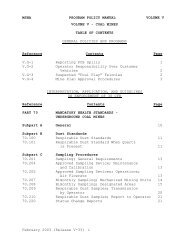MSHA HANDBOOK SERIES - PH13-V-1 - Mine Safety and Health ...
MSHA HANDBOOK SERIES - PH13-V-1 - Mine Safety and Health ...
MSHA HANDBOOK SERIES - PH13-V-1 - Mine Safety and Health ...
You also want an ePaper? Increase the reach of your titles
YUMPU automatically turns print PDFs into web optimized ePapers that Google loves.
GENERAL COAL MINE INSPECTION PROCEDURES AND<br />
INSPECTION TRACKING SYSTEM <strong>HANDBOOK</strong> CHAPTER 5<br />
Chapter 5 - SAMPLING PROCEDURES<br />
A. Air Samples. The location of samples collected shall be no less than 12 inches from<br />
the roof, face, floor <strong>and</strong> ribs. Special collection media may be required to sample for<br />
the presence of dusts, fumes, mists, <strong>and</strong> vapors. The Pittsburgh <strong>Safety</strong> <strong>and</strong> <strong>Health</strong><br />
Technology Center (PSHTC) should be contacted for guidance on special collection<br />
media. (Refer to the IPAL User’s Manual for instructions on filling out <strong>MSHA</strong> Form<br />
2000-43, <strong>Mine</strong> Atmosphere Sample Record.)<br />
Air samples sent to the lab are routinely analyzed for five gases: carbon dioxide<br />
(CO2), oxygen (O2), methane (CH4), ethane (C2H6), <strong>and</strong> nitrogen (N2) (note: the results<br />
of nitrogen are not reported on the analysis of air sample report). The 10-milliliter<br />
(ml) air sample bottles or ‘vac-u-tainers ® ’ shall be used to collect this type of sample.<br />
Additionally, when collecting air samples in vac-u-tainers ® , a plunger (needle) shall<br />
be used to prevent contamination. When transferring air samples from gas sampling<br />
bags to air sample bottles, a double-sided plunger (needle) shall be used to prevent<br />
contamination. Air samples sent to the lab for fire gas analysis/calculations are<br />
routinely acetylene (C2H2), argon (Ar), carbon dioxide (CO2), carbon monoxide (CO),<br />
ethane (C2H6), ethylene (C2H4), hydrogen (H2), methane (CH4), nitrogen (N2), <strong>and</strong><br />
oxygen (O2). For these gases <strong>and</strong> particularly for carbon monoxide (CO) <strong>and</strong><br />
hydrogen (H2) analysis, 50-ml air sample bottles or bag containers shall be used.<br />
When collected, bag samples will be labeled with the date, time, person collecting<br />
the sample <strong>and</strong> the mine location. The bag should be filled two times <strong>and</strong> emptied<br />
after each filling by rolling the bag to expel any air. This process ensures that the gas<br />
sample bag has been purged of any contaminate atmosphere. The gas sample bag<br />
should then be filled to approximately ¾ full or ½ full if the sample is to be shipped<br />
by air. If analysis for carbon monoxide (CO), hydrogen (H2), or other constituents is<br />
needed, indicate the chemical by symbol in the remarks section of <strong>MSHA</strong> Form 2000-<br />
43. Do not use ordinary 10-ml or 50-ml bottles to sample for sulfur dioxide (SO2),<br />
hydrogen sulfide (H2S), oxides of nitrogen, or aldehydes; special testing tubes or<br />
vessels are needed. Contact Tech Support for appropriate sample media <strong>and</strong><br />
techniques.<br />
Air samples shall be collected to substantiate violations citing excessive methane<br />
(CH4), carbon monoxide (CO), carbon dioxide (CO2), <strong>and</strong> low oxygen (O2). When<br />
special samples are collected in connection with a problem arising at a mine or to<br />
substantiate a violation (e.g., less than 19.5 volume per centum of oxygen (O2), more<br />
than 0.5 volume per centum of carbon dioxide (CO2), harmful quantities of other<br />
noxious or poisonous gases), inform laboratory personnel of the problem involved.<br />
Mark the <strong>Mine</strong> Atmosphere Sample Record for special samples with a conspicuous<br />
Release 1 (February 2013) 5-1
















